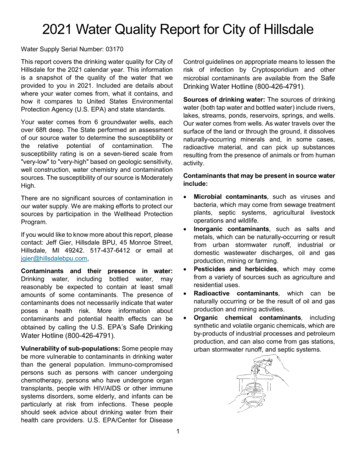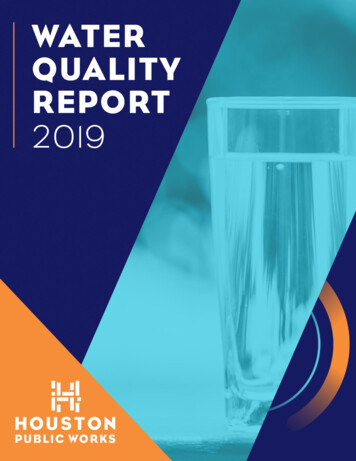
Transcription
2021 Water Quality Report for City of HillsdaleWater Supply Serial Number: 03170This report covers the drinking water quality for City ofHillsdale for the 2021 calendar year. This informationis a snapshot of the quality of the water that weprovided to you in 2021. Included are details aboutwhere your water comes from, what it contains, andhow it compares to United States EnvironmentalProtection Agency (U.S. EPA) and state standards.Control guidelines on appropriate means to lessen therisk of infection by Cryptosporidium and othermicrobial contaminants are available from the SafeDrinking Water Hotline (800-426-4791).Sources of drinking water: The sources of drinkingwater (both tap water and bottled water) include rivers,lakes, streams, ponds, reservoirs, springs, and wells.Our water comes from wells. As water travels over thesurface of the land or through the ground, it dissolvesnaturally-occurring minerals and, in some cases,radioactive material, and can pick up substancesresulting from the presence of animals or from humanactivity.Your water comes from 6 groundwater wells, eachover 68ft deep. The State performed an assessmentof our source water to determine the susceptibility orthe relative potential of contamination. Thesusceptibility rating is on a seven-tiered scale from"very-low" to "very-high" based on geologic sensitivity,well construction, water chemistry and contaminationsources. The susceptibility of our source is ModeratelyHigh.Contaminants that may be present in source waterinclude: There are no significant sources of contamination inour water supply. We are making efforts to protect oursources by participation in the Wellhead ProtectionProgram. If you would like to know more about this report, pleasecontact: Jeff Gier, Hillsdale BPU, 45 Monroe Street,Hillsdale, MI 49242. 517-437-6412 or email atjgier@hillsdalebpu.com, Contaminants and their presence in water:Drinking water, including bottled water, mayreasonably be expected to contain at least smallamounts of some contaminants. The presence ofcontaminants does not necessarily indicate that waterposes a health risk. More information aboutcontaminants and potential health effects can beobtained by calling the U.S. EPA’s Safe DrinkingWater Hotline (800-426-4791). Vulnerability of sub-populations: Some people maybe more vulnerable to contaminants in drinking waterthan the general population. Immuno-compromisedpersons such as persons with cancer undergoingchemotherapy, persons who have undergone organtransplants, people with HIV/AIDS or other immunesystems disorders, some elderly, and infants can beparticularly at risk from infections. These peopleshould seek advice about drinking water from theirhealth care providers. U.S. EPA/Center for Disease1Microbial contaminants, such as viruses andbacteria, which may come from sewage treatmentplants, septic systems, agricultural livestockoperations and wildlife.Inorganic contaminants, such as salts andmetals, which can be naturally-occurring or resultfrom urban stormwater runoff, industrial ordomestic wastewater discharges, oil and gasproduction, mining or farming.Pesticides and herbicides, which may comefrom a variety of sources such as agriculture andresidential uses.Radioactive contaminants, which can benaturally occurring or be the result of oil and gasproduction and mining activities.Organic chemical contaminants, includingsynthetic and volatile organic chemicals, which areby-products of industrial processes and petroleumproduction, and can also come from gas stations,urban stormwater runoff, and septic systems.
In order to ensure that tap water is safe to drink, theU.S. EPA prescribes regulations that limit the levels ofcertain contaminants in water provided by public watersystems. Federal Food and Drug Administrationregulations establish limits for contaminants in bottledwater which provide the same protection for publichealth.Water Quality DataThe table below lists all the drinking water contaminants that we detected during the 2021 calendar year. Thepresence of these contaminants in the water does not necessarily indicate that the water poses a health risk.Unless otherwise noted, the data presented in this table is from testing done January 1 throughDecember 31, 2021. The State allows us to monitor for certain contaminants less than once per year becausethe concentrations of these contaminants are not expected to vary significantly from year to year. All the data isrepresentative of the water quality, but some are more than one year old.Terms and abbreviations used below: Maximum Contaminant Level Goal (MCLG): The level of a contaminant in drinking water below which thereis no known or expected risk to health. MCLGs allow for a margin of safety.Maximum Contaminant Level (MCL): The highest level of a contaminant that is allowed in drinking water.MCLs are set as close to the MCLGs as feasible using the best available treatment technology.Maximum Residual Disinfectant Level (MRDL): The highest level of a disinfectant allowed in drinking water.There is convincing evidence that addition of a disinfectant is necessary for control of microbialcontaminants.Maximum Residual Disinfectant Level Goal (MRDLG): The level of a drinking water disinfectant belowwhich there is no known or expected risk to health. MRDLGs do not reflect the benefits of the use ofdisinfectants to control microbial contaminants.N/A: Not applicableND: not detectable at testing limitppm: parts per million or milligrams per literppb: parts per billion or micrograms per literppt: parts per trillion or nanograms per literpCi/l: picocuries per liter (a measure of radioactivity)Action Level (AL): The concentration of a contaminant which, if exceeded, triggers treatment or otherrequirements that a water system must follow.2
Regulated ContaminantMCL, TT,or MRDLMCLG oTypical Source of ContaminantArsenic (ppb)100NDND2017NoErosion of natural deposits; Runoff fromorchards; Runoff from glass and electronicsproduction wastesBarium (ppm)220.110.112017NoDischarge of drilling wastes; Discharge ofmetal refineries; Erosion of natural depositsNitrate (ppm)1010NDNA2021NoRunoff from fertilizer use; Leaching fromseptic tanks, sewage; Erosion of naturaldepositsFluoride (ppm)440.49NA2019NoErosion of natural deposits; Water additivewhich promotes strong teeth; Discharge fromfertilizer and aluminum factoriesSodium1 (ppm)N/AN/A25NA2019NoErosion of natural depositsTTHM Total ct of drinking water disinfectionHAA5 Haloacetic Acids⁴ (ppb)60N/A8825-882021NoByproduct of drinking water disinfectionChlorine2 (ppm)440.390.011.472021NoWater additive used to control microbesCombined radium (pCi/L)50NDND2015NoErosion of natural depositsTypical Source of ContaminantPer- and polyfluoroalkyl substances (PFAS)Regulated ContaminantMCL, TT,or MRDLMCLG oHexafluoropropylene oxidedimer acid (HFPO-DA) (ppt)370N/ANDNA2021NoPerfluorobutane sulfonic acid(PFBS) (ppt)420N/ANDNA2021NoPerfluorohexane sulfonic acid(PFHxS) (ppt)51N/ANDNA2021NoPerfluorohexanoic acid (PFHxA)(ppt)400,000N/ANDNA2021NoPerfluorononanoic acid (PFNA)(ppt)6N/ANDNA2021No3Discharge and waste from industrial facilitiesutilizing the Gen X chemical processDischarge and waste from industrialfacilities; stain-resistant treatmentsFirefighting foam; discharge and wastefrom industrial facilitiesFirefighting foam; discharge and wastefrom industrial facilitiesDischarge and waste from industrialfacilities; breakdown of precursor compounds
Perfluorooctane sulfonic acid(PFOS) (ppt)16Perfluorooctanoic acid (PFOA)(ppt)8Inorganic Contaminant Subjectto Action Levels (AL)N/ANDNA2021NoFirefighting foam; discharge fromelectroplating facilities; discharge and wastefrom industrial facilitiesDischarge and waste from ngeofResultsYearSampledNumber ofSamplesAbove ALTypical Source of ContaminantLead (ppb)1502.0ND-320210Lead service lines, corrosion of householdplumbing including fittings and fixtures;Erosion of natural depositsCopper (ppm)1.31.30.80.0-2.220211Corrosion of household plumbing systems;Erosion of natural deposits1Sodium is not a regulated contaminant.2The chlorine “Level Detected” was calculated using a running annual average.3Ninety (90) percent of the samples collected were at or below the level reported for our water.⁴ Sample did not result in MCL violation but did trigger more sampling.4facilities; stain-resistant treatments
Information about lead: If present, elevated levels of lead can cause serious health problems, especially forpregnant women and young children. Lead in drinking water is primarily from materials and componentsassociated with service lines and home plumbing. Hillsdale BPU is responsible for providing high qualitydrinking water, but cannot control the variety of materials used in plumbing components. When your water hasbeen sitting for several hours, you can minimize the potential for lead exposure by flushing your tap for30 seconds to 2 minutes before using water for drinking or cooking. If you have a lead service line it isrecommended that you run your water for at least 5 minutes to flush water from both your home plumbing andthe lead service line. If you are concerned about lead in your water, you may wish to have your water tested.Information on lead in drinking water, testing methods, and steps you can take to minimize exposure isavailable from the Safe Drinking Water Hotline or at http://www.epa.gov/safewater/lead.Infants and children who drink water containing lead could experience delays in their physical or mentaldevelopment. Children could show slight deficits in attention span and learning abilities. Adults who drink thiswater over many years could develop kidney problems or high blood pressure.Copper is an essential nutrient, but some people who drink water containing copper in excess of the actionlevel over a relatively short amount of time could experience gastrointestinal distress. Some people who drinkwater containing copper in excess of the action level over many years could suffer liver or kidney damage.People with Wilson’s Disease should consult their personal doctor.Our water supply has 297 lead service lines and 1962 service lines of unknown material out of a total of 2846service lines.Monitoring and Reporting to the Department of Environment, Great Lakes, and Energy (EGLE) Requirements:The State of Michigan and the U.S. EPA require us to test our water on a regular basis to ensure its safety. Wemet all the monitoring and reporting requirements for 2020.We will update this report annually and will keep you informed of any problems that may occur throughout theyear, as they happen. Copies are available at 45 Monroe Street.We invite public participation in decisions that affect drinking water quality. BPU Board Meetings occurregularly on the second Tuesday of each month, in the BPU Board Room at 45 Monroe Street. For moreinformation about your water, or the contents of this report, contact Bill Briggs at 517-437-6412. For moreinformation about safe drinking water, visit the U.S. EPA at http://www.epa.gov/safewater.5
contact: Jeff Gier, Hillsdale BPU, 45 Monroe Street, Hillsdale, MI 49242. 517-437-6412 or email at jgier@hillsdalebpu.com, Contaminants and their presence in water: Drinking water, including bottled water, may reasonably be expected to contain at least small amounts of some contaminants. The presence of











